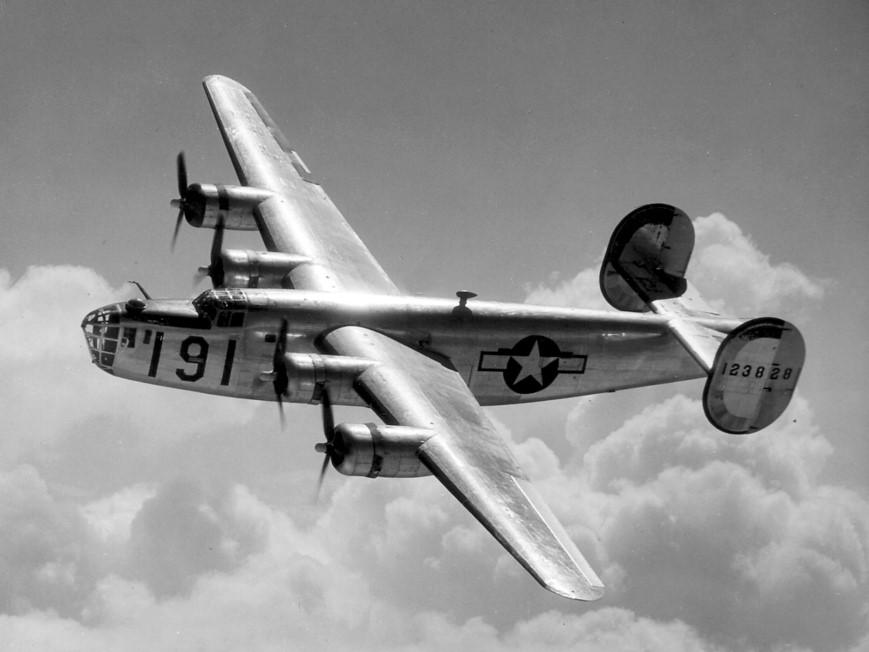Helena, MT – 80 years ago, December 5, 1944, the First Special Service Force held its final formation and deactivation ceremony at Villeneuve-Loubet, France on the Loup River flats.
The First Special Service Force was a unique joint Canadian-American top-secret force constituted under COL Robert T. Frederick on July 9, 1942 at Fort William Henry Harrison west of Helena, Montana. The First Special Service Force was airborne-trained and highly skilled in mountain operations and amphibious assaults with tough, physical training concentrated on weapons proficiency and demolitions. When tested by the US Army prior to deployment, the First Special Service Force scored the highest in infantry proficiency of any unit in the Army.
On August 15, 1943, the First Special Service Force made their first amphibious landing on the island of Kiska in the Aleutian Islands. As part of Operation Cottage, serving with the US 7th Infantry Division and Canadian 6th Infantry Division, the First Special Service Force’s First and Third Regiments landed on the island under the cover of darkness while Second Regiment was in reserve, waiting to parachute onto the island when needed. It was discovered after the landing that the Japanese had left the island under the cover of darkness and fog three days earlier
The First Special Service Force was quickly redeployed to the Mediterranean Theater, arriving in Italy on November 19, 1943. The Force was immediately assigned the task of clearing the German soldiers off Monte la Defensa, along with several other mountain tops of the Winter Line. On the night of December 1, 1943, the First Special Service Force marched 10 miles in the snow and rain of the Italian winter, and under the cover of darkness, to the base of the northern cliffs of Monte la Defensa. The Force waited in silence throughout the day of December 2, close enough to hear the German soldiers talking; close enough to smell their food cooking. Under the cover of darkness on the night of December 2, 2nd Regiment of the First Special Service Force scaled the 300-foot cliffs on the north side of la Defense in fog, rain and snow. By daybreak on the morning of December 3, 300 Forcemen were on top of the mountain when the battle began. Within four hours the men of the First Special Service Force had pushed the German soldiers off la Defensa. For the next six weeks the First Special Force cleared the mountain tops of the Winter Line, fighting north Casino. The First Special Service Force was relieved on January 16, 1943 after 45 days of continuous combat. The Force’s combat echelon on December 3, 1943, the battle of la Defensa, was 1,800 men. On January 16, 1943, when the Force was relieved, fewer than 500 Forcemen came out of the mountains.
On February 2, 1944, the Force moved north and played a key role at Anzio, responsible for eight miles of the right flank with a total combat strength of only 1,200 soldiers. Significantly outnumbered by the Herman Goering Division, the FSSF held a division-sized sector along the Mussolini Canal. For 99 days, the FSSF conducted aggressive night patrols and raids by blackened faced Forceman, earning them the nickname “Black Devils” by the opposing Germans.
On the morning of May23, 1944 the Allies broke out of the Anzio Beachhead, driving toward Rome. The First Special Service Force drove northeast into the mountains surrounding Anzio. For the next two weeks the Force fought through the Lepini heights to Artena and Segni, after capturing Mt. Arrestino. After one week of fighting following the Anzio breakout, the First Special Service Force had lost over 40% of their combat strength. On June 4, 1944 at 6:00 am, a FSSF patrol lead by Captain Mark Radcliffe entered Rome, the first allied unit to enter the German occupied Eternal City. The mission of the First Special Service Force was to secure the Rome bridges crossing the Tiber River before they were destroyed by the retreating German Army. Two days later, June 6, 1944, the largest land, sea, and air invasion ever attempted began, D-Day.
The Mediterranean Campaign of the European Theater was part of the strategy and planning for the D-Day invasion. The First Special Service Force was an integral part of this strategy. Beginning in September, 1943, the Allies pushed the German and Italian military north, liberating the Italian oppressed and eventually liberating Rome. Part of this strategy was also to tie up as many German soldiers as possible in Italy to thin the German ranks available to defend the western shores of Normandy. By January, 1944 a reinforced German Army of 23 divisions, consisted of 215,000 troops engaged in the south and 265,000 troops in reserve in the north. As the Italian Campaign drug on in early 1944, more German troops were moved from France to Italy. Had these German troops been available to defend the D-Day Normandy landings, the outcome may have been much different.
On August 15, 1944, one year to the day after the Kiska landing, the Force made an amphibious landing on Southern France as part of Operation Dragoon and the liberation of Southern France. The Force seized two islands off the coast of Southern France to open the way for the Allied landing force, and then moved to the mainland, fighting northeast along the coast through the towns of Grasse, Plascassiere, and Menton. The Force was in continuous action for the next 15 weeks, engaged in bitter skirmishes to liberate the towns and peaks of Southern France.
On December 5, 1944, the First Special Service Force held its final formation and deactivation ceremony. At 2:00 pm the force gathered on the Loup River flats near Villeneuve-Loubet, France. First the chaplains read a prayer for the final dead who had fallen from Hyeres to Menton to join the honored dead of other campaigns. Then the United States, Canadian and FSSF flags moved forward, and the deactivation orders were read. Slowly the FSSF flag was wound to its staff and the casing slipped over it. Then the Canadians withdrew from ranks and formed their own battalion to march behind the Canadian flag, passing in review front of the U.S. contingent standing with empty ranks.
A quote from The First Special Service Force, A War History of the North Americans 1942-1944, by LTC Robert D Burhans “The Force, as history would know it, had finally dissolved to its national counterparts. An epitaph is not appropriate, for it did not die that afternoon at Villeneuve-Loubet. Its memory is still young in the hearts and minds of families who gave their sons to its ranks, and in the heart of every man who wore the red Spearhead. Rather it can be summed up in the words of Sholto Watt, of the Montreal Standard, who knew the Force best of any man outside it:
I can testify to their spectacular power and efficiency, their marvelous morale and their never-failing spirit of attack. They were exactly what one would expect from North America’s best-an inspiration to see and a terror to their enemy.
But the importance of the First Special Service Force in world history, and their influence on the future, are much greater than even their outstanding military merit would deserve. The significance of this Force is that it was the first joint force of its kind, drawn from two neighbor democracies, and that it was a brilliant success throughout. It is by no means fanciful to see in it the prototype of the world police of that world community which has for so long been the dream of men of goodwill.
Their legend is a feat of arms which will remain celebrated in military history which should be remembered even longer-an example of international brotherhood which deserves enduring honor.
In 251 days of combat the Force suffered 2,314 casualties – 134% of its combat strength. They captured 30,000 German prisoners, won five US campaign stars and eight Canadian battle honors. The Force never failed a mission.
The surviving veterans of the FSSF dedicated a monument to their fallen brothers in August 1947 in Helena’s Memorial Park. The Cenotaph east of the monument includes the names of 488 men who made the ultimate sacrifice in World War II.
Most gratifying to the Veterans of the FSSF is that its traditions and honors have not died but are carried forward, with its lineage embracing the outstanding active Special Forces units of two great democracies: The Canadian Special Operations Regiment and the Special Forces of the United States Army.
On February 3, 2015, the United States Congress presented the Congressional Gold Medal to the First Special Service Force, “In recognition of its superior service during World War II”. Forty-three original FSSF Veterans attended the ceremony at the United States Capitol, along with over 800 family members, friends, and members of Congress.
On August 21, 2015 veterans of the First Special Service Force presented their Congressional Gold Medal to Fort William Henry Harrison, where the Force trained 73 years earlier.
For further information, contact Bill Woon, 461-7485, or Ray Read, 235-0290.
Recent Articles
105th Veterans Day, November 11, 2024
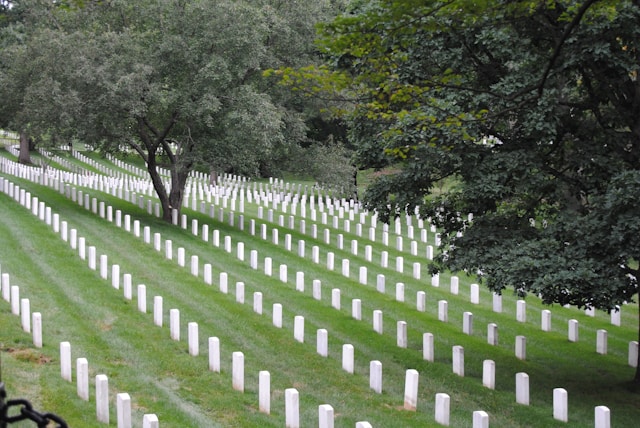
(November 6, 2024) Helena’s Veterans gear up to recognize the 105th Anniversary of Veterans (Armistice) Day on Monday, November 11, 2024. The Lewis & Clark County Veterans Memorial Foundation will celebrate Veterans Day with their program at the Lewis & Clark Veterans Memorial located in Helena’s Memorial Park at 3 p.m. In The Foundation will again recognize the renewal of the Memorial that has been completely refurbished through the effort of the citizens of Helena and Lewis & Clark County.
If adverse weather occurs the ceremony will move to American Post 2 located at 3095 Villard Avenue (corner of Villard Avenue and Custer Avenue).
The Lewis and Clark County Veterans Memorial Foundation is proud to announce that Major General John P. Hronrek, Adjutant General, Montana, serving as Commander of the Montana National Guard and the Director of the Department of Military Affairs as the Event speaker. He is responsible to the Governor of Montana to provide Army and Air National military forces that are ready to deploy worldwide and accomplish military mission in support of national defense, homeland security, natural disasters, domestic emergencies, and military support to state and local government. As the Adjutant General Major General Hronek serves on the Governor’s cabinet as the principle military advisor and is responsible to the Governor for State Disaster and Emergency Management, Homeland Security, Veterans Affairs, Counter-Drug support to Civilian Law Enforcement, the Montana National Guard Youth Challenge Program and the STARBASE Program.
Prior to his appointment as the Adjutant General he served as the Air National Guard Assistant to the Commander, Air Education and Training Command. In this position assisted with formulating, developing, coordinating policies and programs impacting more than 107,000 Air National members.
He is a command pilot with over 4,100 hours in the F-106, F-16, F-15C, and C-130-H. General Hronek served as NGB Director of A5/8/9 Plans, Programs and requirements, Air National Guard Readiness Center, Joint Base Andrews, Maryland, Assistant Adjutant General, Montana Air National Guard, Chief of Staff, Montana Air National Guard and Commander of the 120th Airlift Wing In Great Falls, Montana, MT, where he led the Wing in two major aircraft conversions from the F-16Cto the -15C and the F-15C to the C-130H.
He has served three combat tours in Prince Sultan Air Base, Saudi Arabia, Kukuk Air Force Base, Iraq and Balad Air Base, Iraq.
Other Events:
Post 2, located at 3095 Villard Avenue (corner of Villard Avenue and Custer Avenue) will serve their annual Veterans Day breakfast from 7: a.m.- 10 a.m. Veterans and their families along with Active and National Guard and Reserve military personnel and their families are welcome. East Helena will conduct their annual Veterans Day parade from the VFW Post 10010 at the home to East Helena starting at 11 a.m. with lunch to follow. The Veterans Day event at 3:00 p.m.at the Lewis and Clark County Memorial, Memorial Park Veterans Day occurs on November 11 every year in the United States in honor of the “eleventh hour of the eleventh day of the eleventh month” of 1918 that signaled the end of World War I World War I officially ended when the Treaty of Versailles was signed on June 28, 1919. However, the fighting ended about seven months before that when the Allies and Germany put into effect an armistice on the eleventh hour of the eleventh day of the eleventh month. For that reason, Nov. 11, 1918, was largely considered the end of “the war to end all wars” or The Great War and dubbed Armistice Day. In 1926, Congress officially recognized it as the end of the war, and in 1938, it became an official holiday, primarily a day set aside to honor veterans of World War I. But then World War II and the Korean War happened, so on June 1, 1954, at the urging of veterans’ service organizations, Congress amended the commemoration yet again, by changing the word “armistice” to “veterans” so the day would honor American veterans of all wars and conflicts.History of Veterans Day
World War I – known at the time as “The Great War” – officially ended when the Treaty of Versailles was signed on June 28, 1919, in the Palace of Versailles outside the town of Versailles, France. However, fighting ceased seven months earlier when an armistice, or temporary cessation of hostilities, between the Allied nations and Germany went into effect on the eleventh hour of the eleventh day of the eleventh month. For that reason, November 11, 1918, is generally regarded as the end of “the war to end all wars.” Soldiers of the 353rd Infantry near a church at Stenay, Meuse in France, wait for the end of hostilities. This photo was taken at 10:58 a.m., on November 11, 1918, two minutes before the armistice ending World War I went into effect. In November 1919, President Wilson proclaimed November 11 as the first commemoration of Armistice Day with the following words: “To us in America, the reflections of Armistice Day will be filled with solemn pride in the heroism of those who died in the country’s service and with gratitude for the victory, both because of the thing from which it has freed us and because of the opportunity it has given America to show her sympathy with peace and justice in the councils of the nations…” The original concept for the celebration was for a day observed with parades and public meetings and a brief suspension of business beginning at 11:00 a.m. The United States Congress officially recognized the end of World War I when it passed a concurrent resolution on June 4, 1926, with these words: Whereas the 11th of November 1918, marked the cessation of the most destructive, sanguinary, and far-reaching war in human annals and the resumption by the people of the United States of peaceful relations with other nations, which we hope may never again be severed, and Whereas it is fitting that the recurring anniversary of this date should be commemorated with thanksgiving and prayer and exercises designed to perpetuate peace through good will and mutual understanding between nations; and Whereas the legislatures of twenty-seven of our States have already declared November 11 to be a legal holiday: Therefore be it Resolved by the Senate (the House of Representatives concurring), that the President of the United States is requested to issue a proclamation calling upon the officials to display the flag of the United States on all Government buildings on November 11 and inviting the people of the United States to observe the day in schools and churches, or other suitable places, with appropriate ceremonies of friendly relations with all other peoples. An Act (52 Stat. 351; 5 U. S. Code, Sec. 87a) approved May 13, 1938, made the 11th of November in each year a legal holiday—a day to be dedicated to the cause of world peace and to be thereafter celebrated and known as “Armistice Day.” Armistice Day was primarily a day set aside to honor veterans of World War I, but in 1954, after World War II had required the greatest mobilization of soldiers, sailors, Marines and airmen in the Nation’s history; after American forces had fought aggression in Korea, the 83rd Congress, at the urging of the veterans service organizations, amended the Act of 1938 by striking out the word “Armistice” and inserting in its place the word “Veterans.” With the approval of this legislation (Public Law 380) on June 1, 1954, November 11th became a day to honor American veterans of all wars. Later that same year, on October 8th, President Dwight D. Eisenhower issued the first “Veterans Day Proclamation” which stated: “In order to insure proper and widespread observance of this anniversary, all veterans, all veterans’ organizations, and the entire citizenry will wish to join hands in the common purpose. Toward this end, I am designating the Administrator of Veterans’ Affairs as Chair of a Veterans Day National Committee, which shall include such other persons as the Chair may select, and which will coordinate at the national level necessary planning for the observance. I am also requesting the heads of all departments and agencies of the Executive branch of the Government to assist the National Committee in every way possible.” President Eisenhower signing HR7786, changing Armistice Day to Veterans Day. From left: Alvin J. King, Wayne Richards, Arthur J. Connell, John T. Nation, Edward Rees, Richard L. Trombla, Howard W. Watts On that same day, President Eisenhower sent a letter to the Honorable Harvey V. Higley, Administrator of Veterans’ Affairs (VA), designating him as Chairman of the Veterans Day National Committee. In 1958, the White House advised VA’s General Counsel that the 1954 designation of the VA Administrator as Chair of the Veterans Day National Committee applied to all subsequent VA Administrators. Since March 1989 when VA was elevated to a cabinet level department, the Secretary of Veterans Affairs has served as the committee’s chair. The Uniform Holiday Bill (Public Law 90-363 (82 Stat. 250)) was signed on June 28, 1968, and was intended to ensure three-day weekends for Federal employees by celebrating four national holidays on Mondays: Washington’s Birthday, Memorial Day, Veterans Day, and Columbus Day. It was thought that these extended weekends would encourage travel, recreational and cultural activities and stimulate greater industrial and commercial production. Many states did not agree with this decision and continued to celebrate the holidays on their original dates. The first Veterans Day under the new law was observed with much confusion on October 25, 1971. It was quite apparent that the commemoration of this day was a matter of historic and patriotic significance to a great number of our citizens, and so on September 20th, 1975, President Gerald R. Ford signed Public Law 94-97 (89 Stat. 479), which returned the annual observance of Veterans Day to its original date of November 11, beginning in 1978. This action supported the desires of the overwhelming majority of state legislatures, all major veterans service organizations and the American people. Veterans Day continues to be observed on November 11, regardless of what day of the week on which it falls. The restoration of the observance of Veterans Day to November 11 not only preserves the historical significance of the date but helps focus attention on the important purpose of Veterans Day: A celebration to honor America’s veterans for their patriotism, love of country, and willingness to serve and sacrifice for the common good. Taken from Department of Veterans Affairs website : http://www.va.govMontana’s Merci Car
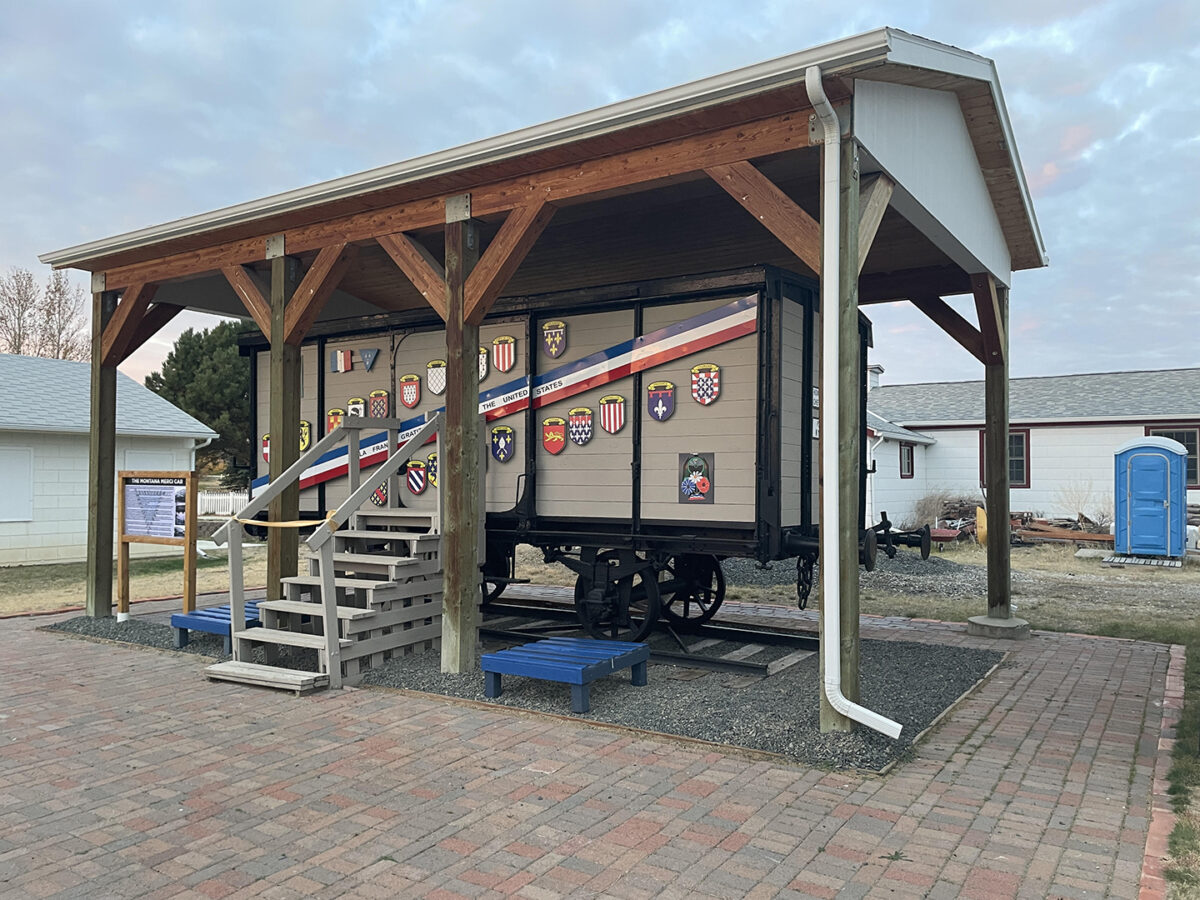
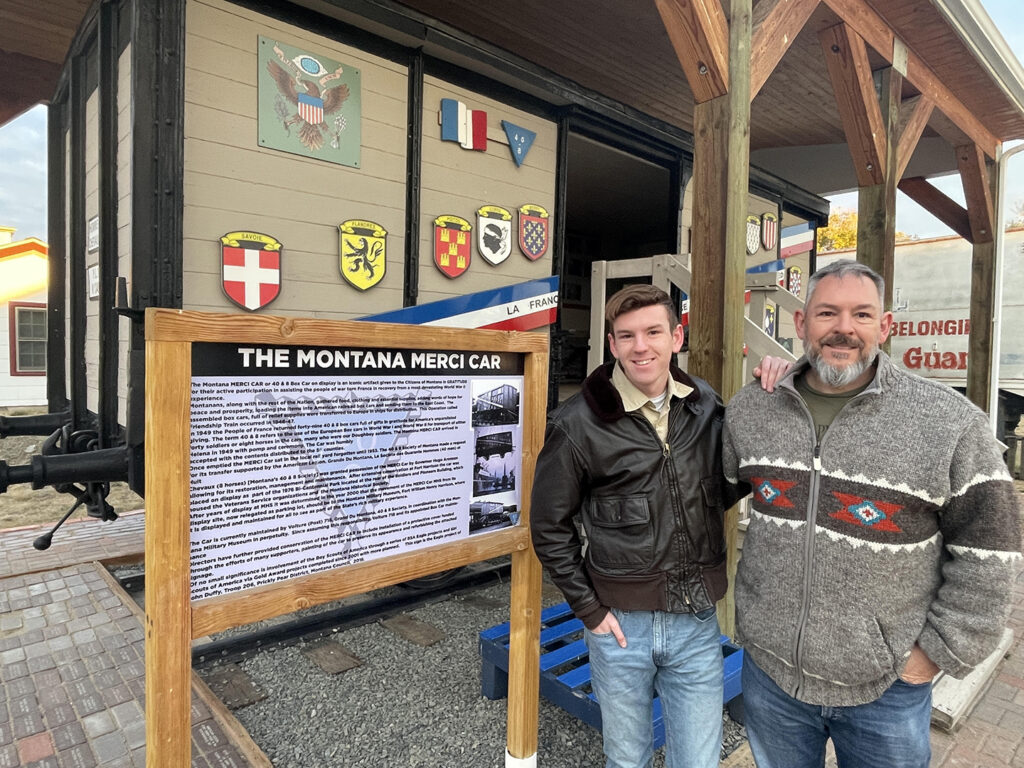
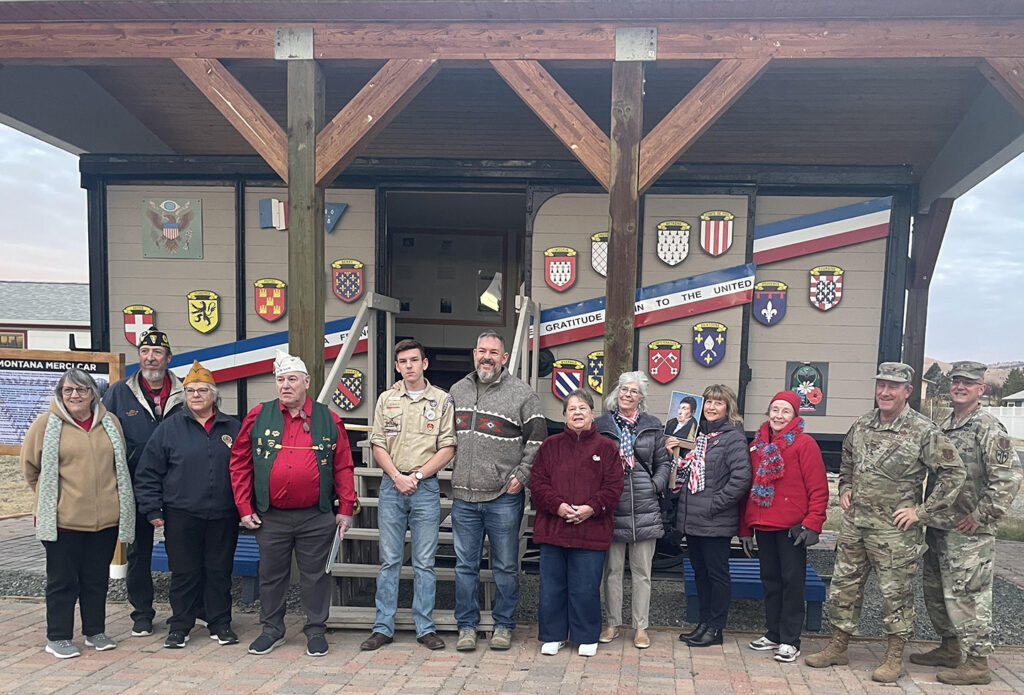
By Phil Drake, Independent Record
A rededication and 75th anniversary observance of Montana’s Merci Car, a gift from the people of France to the state after World War II, as held Friday at the Montana Military Museum at Fort William Henry Harrison.
Among those attending was Tieren Bussell, 18, a Capital High School senior who, along with dad Stephen and about two dozen volunteers, renovated the foundation of the area where the rail car sits. Bussell, a member of Boy Scout Troop 214, estimated about 130 hours into the project by his crew. Approval of his Eagle project is pending.
Bussell, whose hobby as a World War I reenactor stokes his interest in history, approached American Legion Lewis and Clark Post No. 2 to ask about a project and they suggested the Merci Car, his dad said.
Tieren and Stephen Bussell said they removed grass, put in brick around the base of the rail car, replaced damaged brick, power-washed bird poop off the car and did general cleanup. Ray Read, director of the military museum, noted they also made an “MT” for Montana with decorative brick. Tieren estimated less than $1,000 was spent on materials.
“I think it was pretty amazing,” Stephen Bussell said of his son’s project. “Just looking at the before and after pictures, it cleaned it up a lot.”
Tieren cut the rededication ribbon in a ceremony attended by members of the Oro Fino Chapter of the Daughters of the American Revolution, American Legion and Montana National Guard.
Read appreciated the work as well.
“It’s fantastic,” he said.
The Merci Car was a gift from the people of France in 1949, after having received aid from a grassroots effort by Americans to provide them with much-needed items after World War II. They sent 49 box cars filled with presents to the United States.
Montana’s box car was presented to the people of Montana on Feb. 16, 1949, at a ceremony in the state Capitol in front of a joint session of the Legislature and presented to Gov. John Bonner by Paul Lenier, French vice-counsel.
It was eventually moved to the military museum.
Montana State Veteran’s Cemetery POW/MIA Memorial


Farewell to James William Duffy
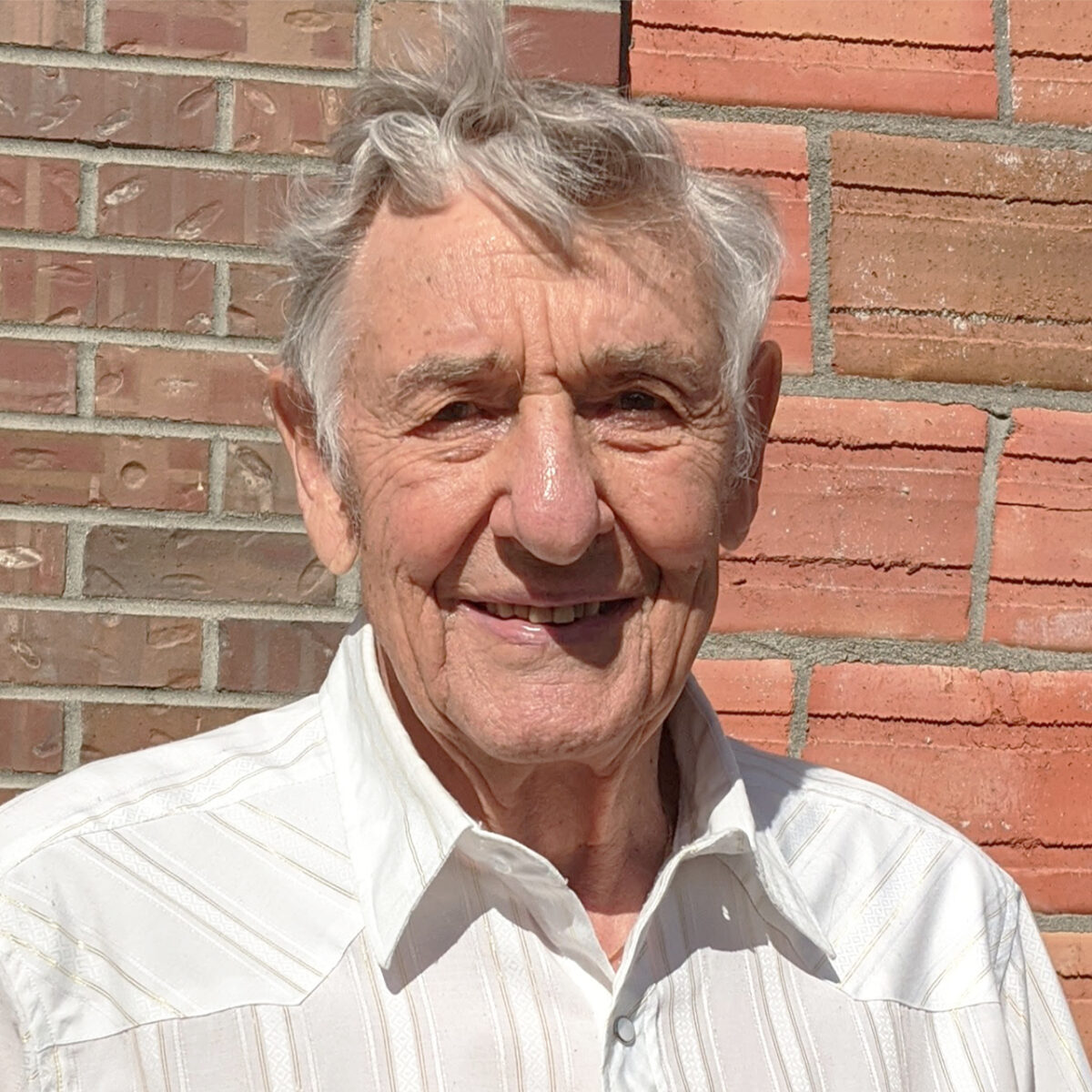
James William Duffy
- James William Duffy, American military officer
- Decorated Army Commendation medal, Meritorious Service medal, Legion of Merit
- Member Helena Chamber of Commerce, Great Falls Chamber of Commerce
- Member of Montana National Guard Association, National Guard Association of the United States, Helena Lions Club
Background
- Duffy, James William was born on February 17, 1930 in Mullan, Idaho, United States. Son of Bernard Bevan and Mary Teresa (Hrella) Duffy.
Education
- Attended, Carroll College, 1948—1950
- Graduate, Command and General Staff College, 1975
- Graduate, Civil Defense Management School, 1980
Career
- Operator farm Helena Valley, Montana, 1950—1955.
- Commissioned Second lieutenant Medical Services Corps Montana Army National Guard, 1956, promoted to major general, 1981. Detachment Commander Separate Detachment 1049th Engineer Company, 1960—1963, Headquarters Detachment, 1963, assistant G-1, 1970, reassigned as assistant G-4, 1972.
- Military Support to Civil Authorities Section, 1973.
- Director State Area Command, 1980.
- Adjunct general State of Montana, Helena, since 1981.
Achievements
- James William Duffy has been listed as a noteworthy military officer by Marquis Who’s Who.
Membership
- Member Helena Chamber of Commerce
- Great Falls Chamber of Commerce
- Member of Montana National Guard Association, National Guard Association of the United States, Helena Lions Club
Connections
- Married Barbara Joan Mergenthaler, August 28, 1954
- Children: Jeanne, Joan, William, Jeffrey, Daniel
Farewell to Pat McCain
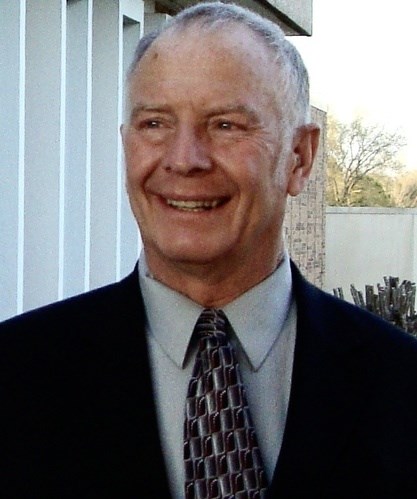
Patrick E McCain
January 27, 1947 – September 23, 2024 On the afternoon of September 23, Pat went to be with the Lord surrounded by his loving wife, two sons, and daughter who played peaceful music to him as he took his final breaths. Pat was born in Great Falls, MT on January 27,1947. He was the third child and only son of Pat and Vivian McCain with older sisters Jetta and Sis. Pat grew up in Great Falls and stood on the corner selling the Great Falls Tribune as a young boy; he graduated from Great Falls High School and traveled with his longtime friend Dick Baker to Alaska and all around the country stopping to work various places along the way including a peach factory in Georgia. In 1965 he enlisted in the US Marine Corp and was a decorated US Marine Corps Veteran who served in the Republic of Vietnam. Upon discharge, he joined the Montana Army Guard and became a commissioned officer. Pat served on various committees of the Montana Military Museum and was also instrumental in the passage of House Bill 255 which recognized Vietnam veterans and established every March 29 as “Welcome Home Vietnam Veteran’s Day”. He was a long-term member of Lewis and Clark American Legion Post in Helena; Pat was very active in politics and never minced words when expressing his opinion! Pat graduated from U of M in Missoula and became a soil scientist, mapping the soils in Lewis & Clark County and various locations in Montana. He was fondly referred to as the “mayor of Elk Park” as Pat could talk to anybody and was able to map private land that had been previously inaccessible. While in Missoula he met and married his wife Kathy and together they became the parents of three children Rob (1974), Corrina (1977), and Dan (1981). Pat was most proud of his children and later his grandchildren Gabe, Levi, and Alexa and loved them more than anything. He loved taking the kids backpacking, sledding, and hunting. His favorite time of year was Christmas and for many years he would take his family out to cut the largest tree he could manage to drag out of the woods. Every year he would sit in the chair while kids decorated the tree and made sure they put on a ton of tinsel! Pat was preceded in death by his parents Pat and Vivian McCain, brothers-in-law Neil Johnson, Irwin Reese, and Jim Colwell, nephews Mike Hastings, Todd Keyser, and Brenden Johnson. Pat is survived by his wife of over 50 years, Kathy, children Rob (Bettina), Corrina (Garry) and Dan, grandchildren Gabe, Levi and Alexa Yadon, sisters Jetta Johnson and Sis McCain (Tony), sisters and brothers-in-law Virginia and Richard Harmon, Glory Reese, and Connie and Allen Keyser as well as many nieces and nephews that he was very close to. Pat spent many hours at Ft Harrison working on various committees with Ray Read at the Military Museum. In lieu of flowers consider donating in Pat’s name to Montana Military Museum at Ft Harrison or charity of your choice. The family would like to thank the wonderful and caring staff at the SW Montana Veteran’s Home in Butte where Pat received the most loving and personal care from all of the staff there. A celebration of Pat’s life will be held on Thursday Oct. 3 at 2:00 at the Chapel at Fort Harrison (main gate by statue and straight one block and then right look for balloons or small flags) with graveside service to follow at 3:00 at Fort Harrison cemetery. Pat was a wonderful friend, especially to Montana’s Vietnam vets. He assisted Ray with many remembrance ceremonies to help keep the memories of their service in our hearts. We will miss Pat dearly.Vigilante Day Parade
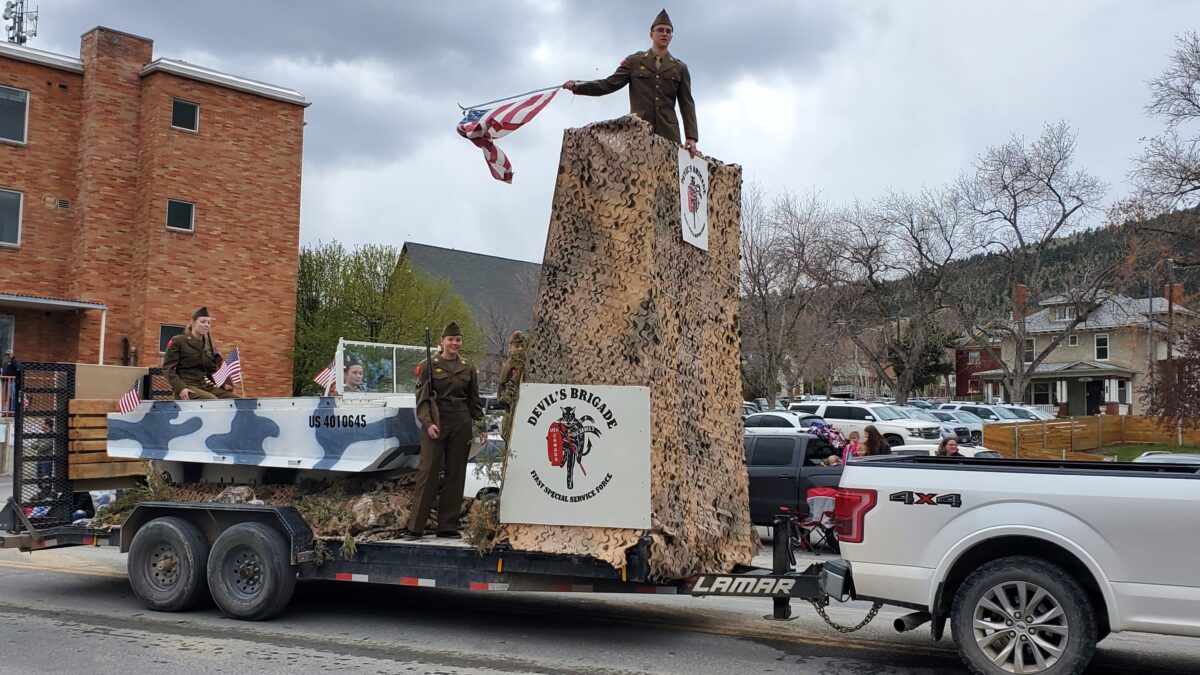
A group of students honoring the Devil’s Brigade soldiers took part in the Vigilante Day parade held in Helena, May 3rd, 2024. The Montana Military Museum provided uniforms, extensive support and other materials to help create their float “The Devil’s Brigade” in the parade. They were awarded the “Most Historical” award of the parade.
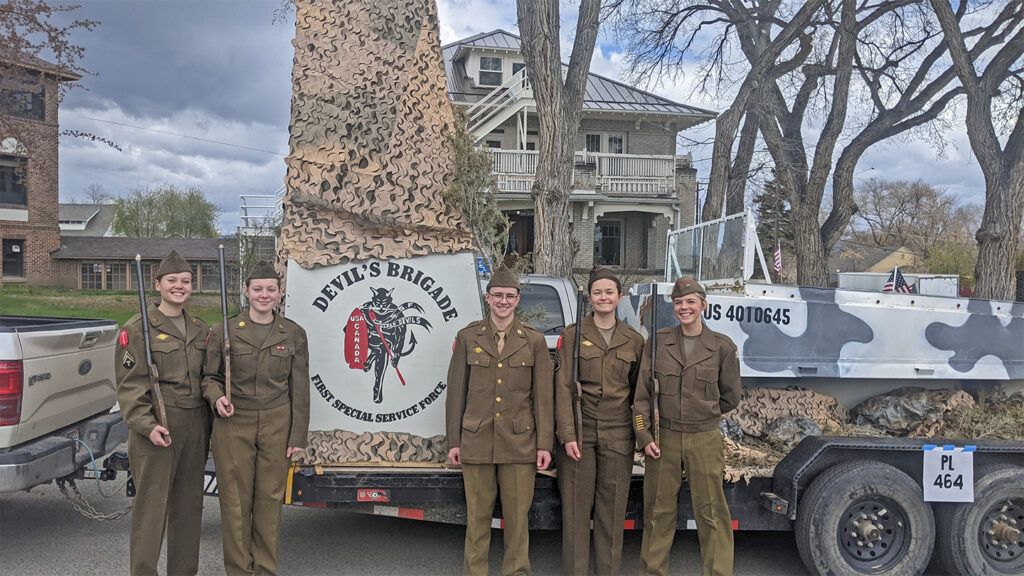
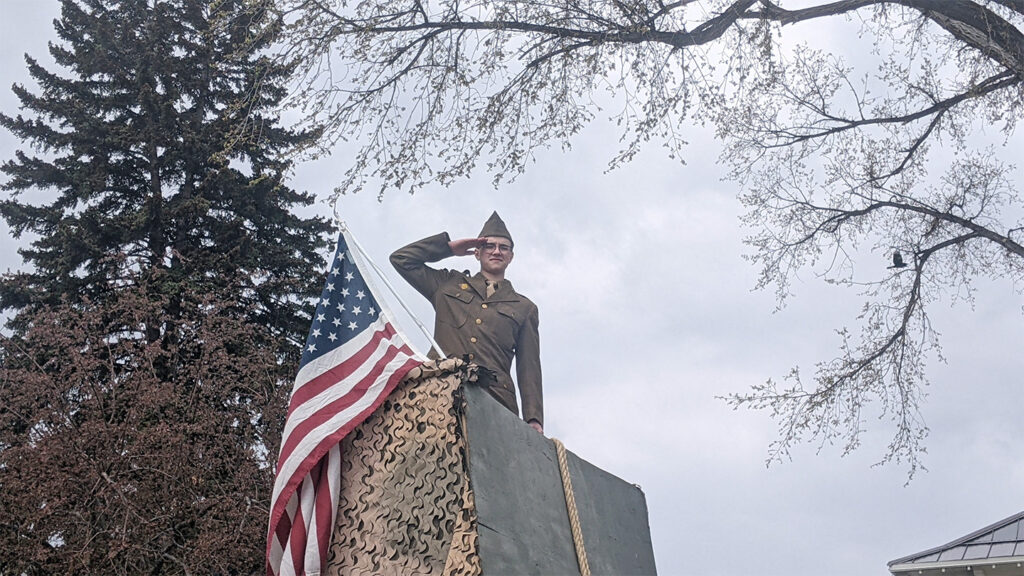
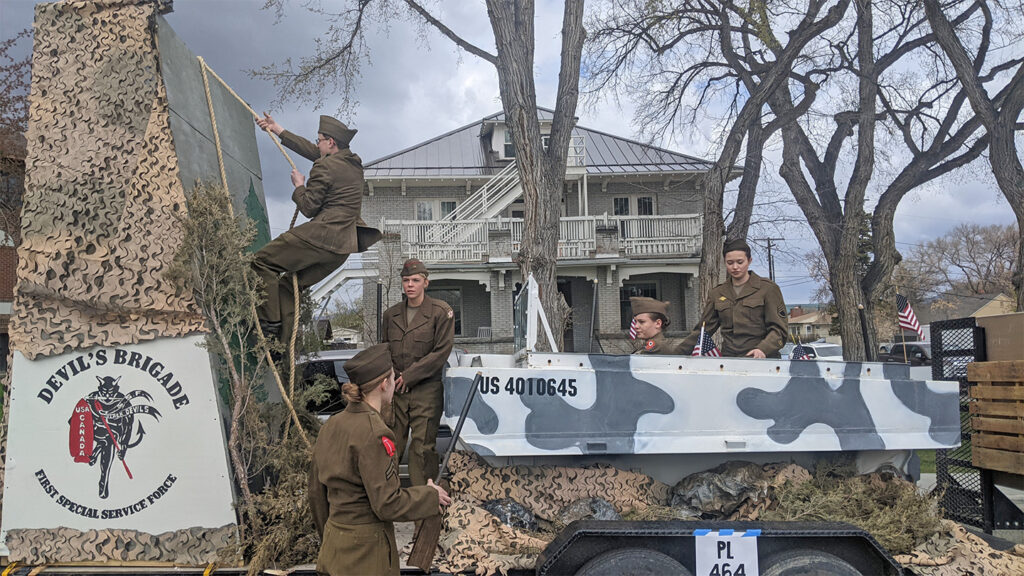
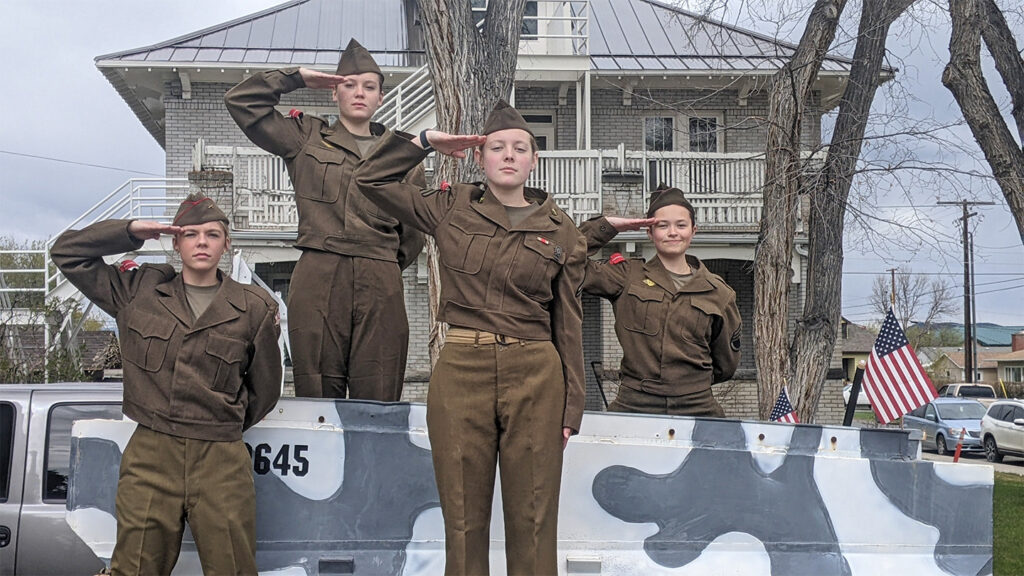

21th Anniversary of 9/11 September 11, 2001 – Press Release
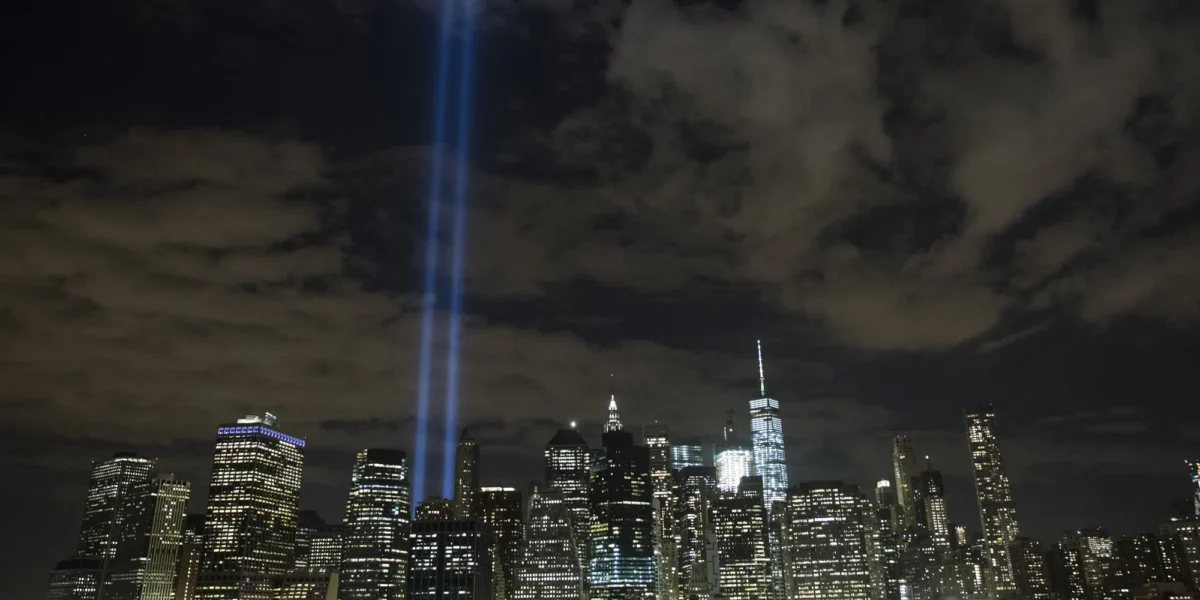
On September 11, 2001, 19 militants associated with the Islamic extremist group al-Qaeda hijacked four US airliners and carried out suicide attacks against targets in the United States. Two of the planes were flown into the towers of the World Trade Center in New York City, a third plane hit the Pentagon just outside Washington, D.C., and the fourth plane was forced down and crashed in a field in Pennsylvania.
Referred to as 9/11, the attacks resulted in extensive death and destruction, triggering major U.S. initiatives to combat terrorism and forever defining the presidency of George W. Bush. Over 3,000 people were killed during the attacks in New York City Pennsylvania and Washington, D.C., including more than 400 police officers and firefighters who rushed to save lives without regard to their own lives.
Fort William Henry Harrison, MT – September 09, 2024:
The Montana Military Museum is reminding all that Wednesday, September 11, 2024, is the 23st Anniversary of the 9-11 attack on the United States and initiation of U.S. efforts to combat terrorism.
The Global War on Terror has affected Montana, especially its men and women citizens serving in the military, some who have given their lives in the on-going conflict and still affects those today who work under conditions that continues to define our times daily.
The Museum invites the Helena area community to come out to the Montana Military Museum located on historic Fort William Henry Harrison on to view the small exhibit display that have been developed in response to the events of 9-11. The Montana Military Museum is open Thursdays from 9:00 a.m. to 4:00 p.m and special hours upon request. On display is the Special 9/11 Commemoration Flag containing all the names of those who were lost on that fateful day. A Book of Remembrances is available for signing.
Since the 9-11Anniversary occurs on Wednesday this year, it hoped that the Helena area citizens take time to say prayers for those who lost their life in the 9-11 attacks and participate in any scheduled events. It is to remember the lives lost and the many Americans who have served and are still serving in a myriad of ways to keep us free from fear of such acts of terror. Give them support in their duties and bring them home safely to their family and friends.
Currently on display at the Helena Armed Forces Reserve Center, Fort Harrison is the Fallen Soldier Memorial dedicated to Montana’s losses in the Global War on Terror in actions as Operations Iraqi Freedom and New Dawn and Afghanistan’s Operation Enduring Freedom. This is available during normal operating hours, Monday through Friday.
The Fallen Soldier Memorial is provided by the Robert Koontz Family and others who designed and built the memorial to Montana’s fallen soldiers who have paid the ultimate price in the Global War on Terror from 2001 to the present. The continued display is the result of a lot of hard work by the many volunteers who support idea of telling the story of Montana’s men and women serving in military service and sacrifice throughout World as part of force to insure security and freedom.
The Montana Military Museum is located at Montana National Guard Training Center, Fort William Henry Harrison. Entry is through the main gate on Williams Street. The Museum complex is located on Mt Majo Street to the right past the Fort Harrison Military entrance. Look for the signs, and outside museum displays.
If you have any questions, please contact Raymond Read, Director of the Montana Military Museum at 406-324-3550 or at 406-458-9847/406-235-0290. Website www.montanamilitarymuseum.org Email info@montanamilitarymuseum.org The Department of Military Affairs, Montana, sponsors the Museum. The Museum’s scope is Montana Military History from the Lewis and Clark’s Corps of Discovery to the present War of Terrorism. Exhibits tell the rich history Montanans in military service in war and peace in all services. The Montana Military Museum is financially supported through the efforts of membership and donations. The Fort William Henry Harrison Museum Foundation, a Montana public corporation, is recognized as a 501(c) (3) non-profit for purposes of public education.
Memorial Week/ Day Activities Abound in Helena, East Helena, and Fort HarrisonPress Release
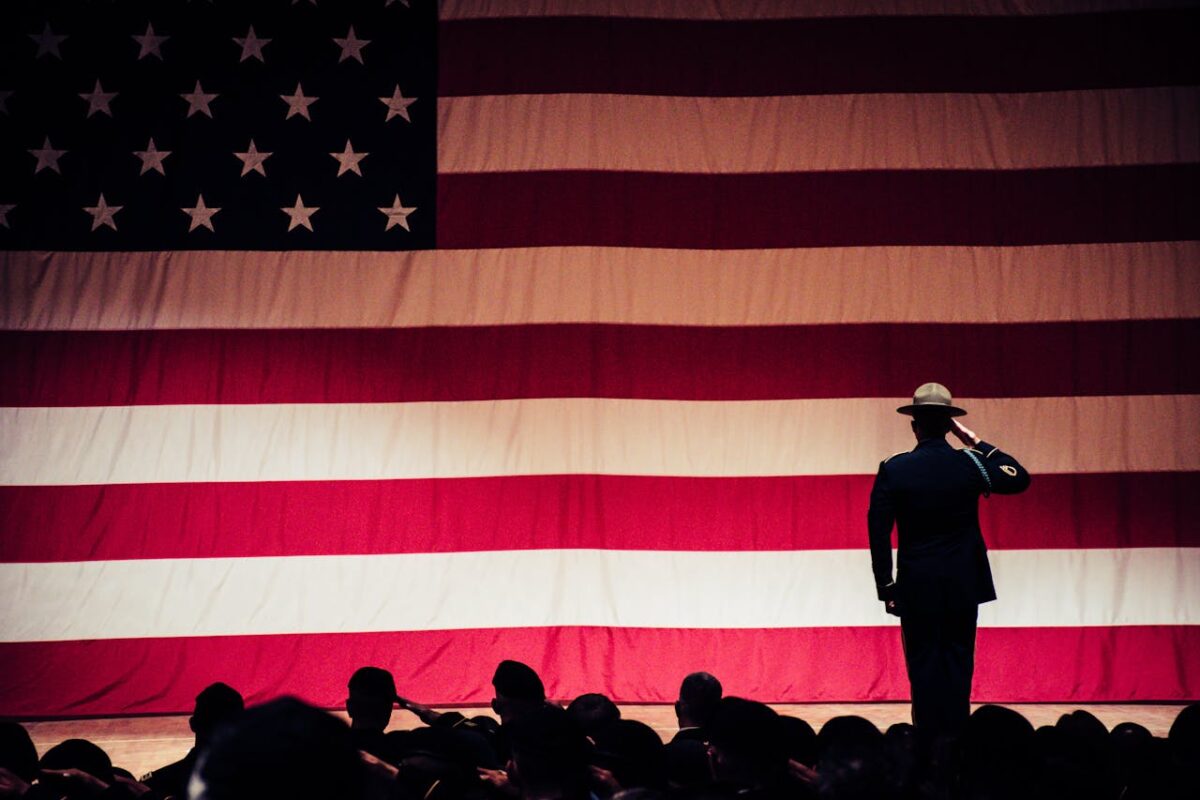
FORT HARRISON/ HELENA, MT, May 19, 2024
Lewis and Clark County Veterans Memorial Foundation will conduct a traditional Memorial Day ceremony at the Lewis & Clark Count Veterans Memorial, located in Memorial Park, Helena at 3:00 p.m. on Thursday, May 30, 2024.
We invite all Gold Star families, area veterans, their families and the Citizens of the City of Helena and Lewis & Clark County to attend this 156th anniversary of Memorial day.
This solemn ceremony is to recognize U.S., Montana and Lewis Clark County veterans who paid the ultimate price through their selfless service.
The Lewis and Clark County Veterans Memorial was dedicated on August 15, 1949, by the Citizens of this County, to recognize their sacrifice and further resolve to honor their legacy through taking care of this community tribute to them.
In case of inclement weather, the Ceremony will be moved Lewis and Clark, American Legion Post 2, 3095 Villard Avenue at the same time.
The Guest speaker is Lowell Long, a Montana Veteran, currently serving as the State Commander, Montana Department, The American Legion. Long served on Active Duty with the United States
Marine Corps Stateside and overseas in Okinawa. Once discharged from the USMC, Long joined
Montana Army National Guard. During his subsequent service he deployed in 2003-2004 with the Montana 639th Quartermaster Company as a logistician in Operation Iraqi Freedom. Long retired from the Montana Army National Guard in 2006.
Lowell served as a career High School Teacher of Special Education in Harlem Elementary School, Harlem, Montana. He recently retired from teaching but still serves his community of Chinook and the State of Montana in various volunteer capacities. He a long-standing member of the American Legion Boys State Committee
Commander Long has served last two years as the State Commander, Montana Department of Montana, The American Legion. The American Legion. He is responsible for nearly 15,000+ American Legion family members.
*** Other Memorial Day/Week events include:
Posting of Flags in Helena for Memorial Day activities on May 27(observed)and 30 the (traditional). Posting of flags on veterans’ graves Montana Veterans Division Cemetery at Fort Harrison on Friday May 24 and in local cemeteries on Saturday May 25. Flags will be picked up on June 3. Flags provided by American Legion Post 2. This will be followed by a road cleanup on Custer Avenue. Volunteers are invited to meet at Lewis and Clark Post, 3095 Villard, at 9:00-10:00 a.m. for instructions and move to the Forestvale Cemetery at 10:00 a.m. Veterans of Foreign Wars, Post 10010, East Helena will conduct their annual Memorial Day Parade on Monday, May 27, 2024 (the Federally/State Holiday). The Parade begins as VFW Post 10010 3-3-3 Memorial Week Activities Around Helena, East Helena and Fort Harrison and proceeds to JFK Park for a Ceremony. Upon completion the Parade will return to the Post where a luncheon will be served. The Traditional Memorial Day Ceremony will be conducted at the Montana Veterans Affairs Division, State of Montana Cemetery located at historic Fort William Henry Harrison at 1:00 p.m., Thursday May 30, 2024. The guest speaker is BG Renea Dorvall, Assistant Adjutant General-Army. BG General Dorvall also serves as the Commander of the Montana Army National Guard. After 36 years of total service, Colonel Renea Dorvall was promoted to Brigadier General, becoming the first woman soldier in the Montana Army National Guard to have that title and grade.Liberator: A Gift From Above Podcast
